Zhengyu Zhang
Deep Learning Based Dynamic Environment Reconstruction for Vehicular ISAC Scenarios
Aug 07, 2025



Abstract:Integrated Sensing and Communication (ISAC) technology plays a critical role in future intelligent transportation systems, by enabling vehicles to perceive and reconstruct the surrounding environment through reuse of wireless signals, thereby reducing or even eliminating the need for additional sensors such as LiDAR or radar. However, existing ISAC based reconstruction methods often lack the ability to track dynamic scenes with sufficient accuracy and temporal consistency, limiting the real world applicability. To address this limitation, we propose a deep learning based framework for vehicular environment reconstruction by using ISAC channels. We first establish a joint channel environment dataset based on multi modal measurements from real world urban street scenarios. Then, a multistage deep learning network is developed to reconstruct the environment. Specifically, a scene decoder identifies the environmental context such as buildings, trees and so on; a cluster center decoder predicts coarse spatial layouts by localizing dominant scattering centers; a point cloud decoder recovers fine grained geometry and structure of surrounding environments. Experimental results demonstrate that the proposed method achieves high-quality dynamic environment reconstruction with a Chamfer Distance of 0.29 and F Score@1% of 0.87. In addition, complexity analysis demonstrates the efficiency and practical applicability of the method in real time scenarios. This work provides a pathway toward low cost environment reconstruction based on ISAC for future intelligent transportation.
A Versatile Pathology Co-pilot via Reasoning Enhanced Multimodal Large Language Model
Jul 23, 2025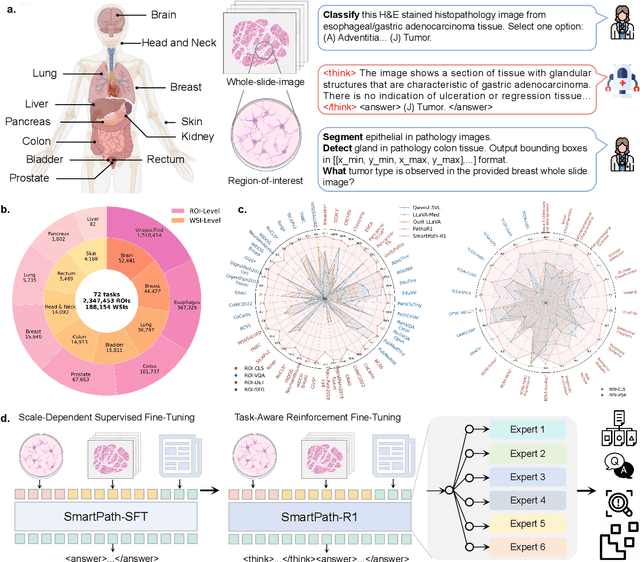
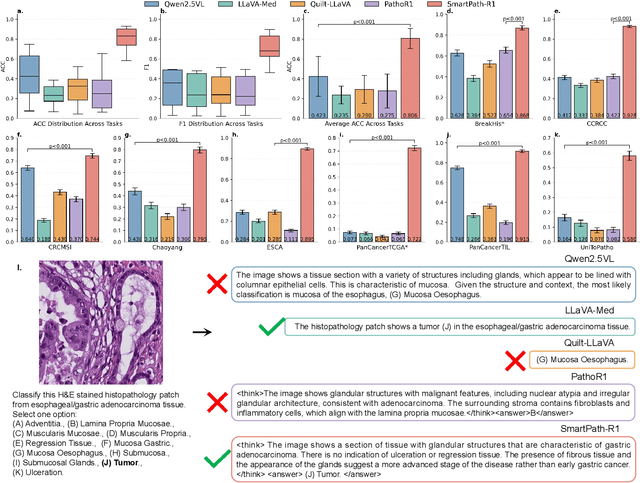
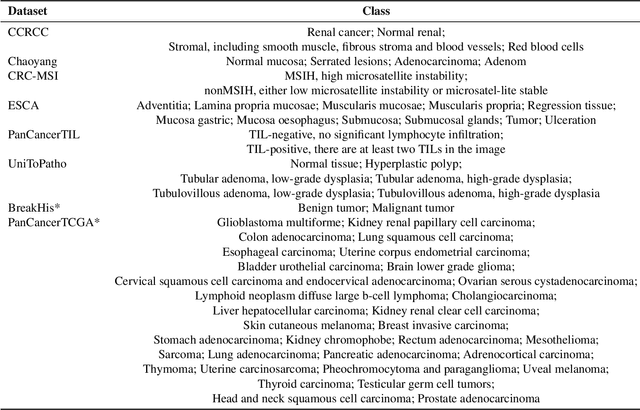
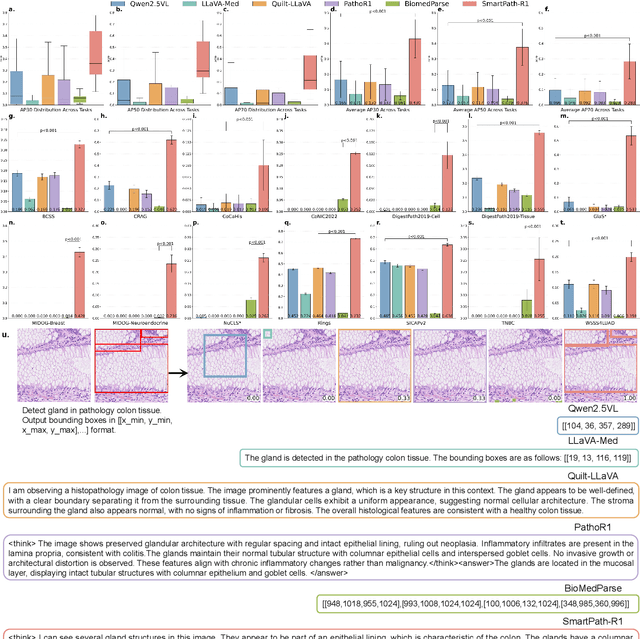
Abstract:Multimodal large language models (MLLMs) have emerged as powerful tools for computational pathology, offering unprecedented opportunities to integrate pathological images with language context for comprehensive diagnostic analysis. These models hold particular promise for automating complex tasks that traditionally require expert interpretation of pathologists. However, current MLLM approaches in pathology demonstrate significantly constrained reasoning capabilities, primarily due to their reliance on expensive chain-of-thought annotations. Additionally, existing methods remain limited to simplex application of visual question answering (VQA) at region-of-interest (ROI) level, failing to address the full spectrum of diagnostic needs such as ROI classification, detection, segmentation, whole-slide-image (WSI) classification and VQA in clinical practice. In this study, we present SmartPath-R1, a versatile MLLM capable of simultaneously addressing both ROI-level and WSI-level tasks while demonstrating robust pathological reasoning capability. Our framework combines scale-dependent supervised fine-tuning and task-aware reinforcement fine-tuning, which circumvents the requirement for chain-of-thought supervision by leveraging the intrinsic knowledge within MLLM. Furthermore, SmartPath-R1 integrates multiscale and multitask analysis through a mixture-of-experts mechanism, enabling dynamic processing for diverse tasks. We curate a large-scale dataset comprising 2.3M ROI samples and 188K WSI samples for training and evaluation. Extensive experiments across 72 tasks validate the effectiveness and superiority of the proposed approach. This work represents a significant step toward developing versatile, reasoning-enhanced AI systems for precision pathology.
Prototypical Progressive Alignment and Reweighting for Generalizable Semantic Segmentation
Jul 16, 2025Abstract:Generalizable semantic segmentation aims to perform well on unseen target domains, a critical challenge due to real-world applications requiring high generalizability. Class-wise prototypes, representing class centroids, serve as domain-invariant cues that benefit generalization due to their stability and semantic consistency. However, this approach faces three challenges. First, existing methods often adopt coarse prototypical alignment strategies, which may hinder performance. Second, naive prototypes computed by averaging source batch features are prone to overfitting and may be negatively affected by unrelated source data. Third, most methods treat all source samples equally, ignoring the fact that different features have varying adaptation difficulties. To address these limitations, we propose a novel framework for generalizable semantic segmentation: Prototypical Progressive Alignment and Reweighting (PPAR), leveraging the strong generalization ability of the CLIP model. Specifically, we define two prototypes: the Original Text Prototype (OTP) and Visual Text Prototype (VTP), generated via CLIP to serve as a solid base for alignment. We then introduce a progressive alignment strategy that aligns features in an easy-to-difficult manner, reducing domain gaps gradually. Furthermore, we propose a prototypical reweighting mechanism that estimates the reliability of source data and adjusts its contribution, mitigating the effect of irrelevant or harmful features (i.e., reducing negative transfer). We also provide a theoretical analysis showing the alignment between our method and domain generalization theory. Extensive experiments across multiple benchmarks demonstrate that PPAR achieves state-of-the-art performance, validating its effectiveness.
Deep Learning-based Human Gesture Channel Modeling for Integrated Sensing and Communication Scenarios
Jul 09, 2025Abstract:With the development of Integrated Sensing and Communication (ISAC) for Sixth-Generation (6G) wireless systems, contactless human recognition has emerged as one of the key application scenarios. Since human gesture motion induces subtle and random variations in wireless multipath propagation, how to accurately model human gesture channels has become a crucial issue for the design and validation of ISAC systems. To this end, this paper proposes a deep learning-based human gesture channel modeling framework for ISAC scenarios, in which the human body is decomposed into multiple body parts, and the mapping between human gestures and their corresponding multipath characteristics is learned from real-world measurements. Specifically, a Poisson neural network is employed to predict the number of Multi-Path Components (MPCs) for each human body part, while Conditional Variational Auto-Encoders (C-VAEs) are reused to generate the scattering points, which are further used to reconstruct continuous channel impulse responses and micro-Doppler signatures. Simulation results demonstrate that the proposed method achieves high accuracy and generalization across different gestures and subjects, providing an interpretable approach for data augmentation and the evaluation of gesture-based ISAC systems.
PathBench: A comprehensive comparison benchmark for pathology foundation models towards precision oncology
May 26, 2025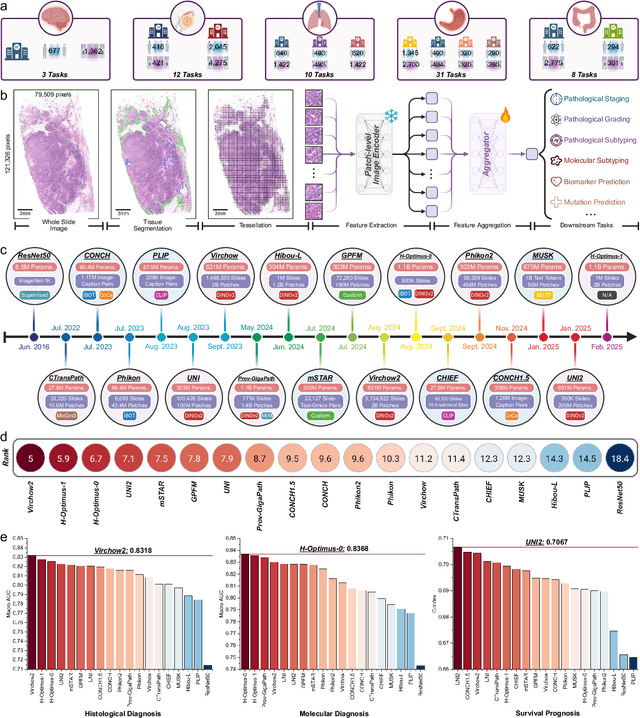



Abstract:The emergence of pathology foundation models has revolutionized computational histopathology, enabling highly accurate, generalized whole-slide image analysis for improved cancer diagnosis, and prognosis assessment. While these models show remarkable potential across cancer diagnostics and prognostics, their clinical translation faces critical challenges including variability in optimal model across cancer types, potential data leakage in evaluation, and lack of standardized benchmarks. Without rigorous, unbiased evaluation, even the most advanced PFMs risk remaining confined to research settings, delaying their life-saving applications. Existing benchmarking efforts remain limited by narrow cancer-type focus, potential pretraining data overlaps, or incomplete task coverage. We present PathBench, the first comprehensive benchmark addressing these gaps through: multi-center in-hourse datasets spanning common cancers with rigorous leakage prevention, evaluation across the full clinical spectrum from diagnosis to prognosis, and an automated leaderboard system for continuous model assessment. Our framework incorporates large-scale data, enabling objective comparison of PFMs while reflecting real-world clinical complexity. All evaluation data comes from private medical providers, with strict exclusion of any pretraining usage to avoid data leakage risks. We have collected 15,888 WSIs from 8,549 patients across 10 hospitals, encompassing over 64 diagnosis and prognosis tasks. Currently, our evaluation of 19 PFMs shows that Virchow2 and H-Optimus-1 are the most effective models overall. This work provides researchers with a robust platform for model development and offers clinicians actionable insights into PFM performance across diverse clinical scenarios, ultimately accelerating the translation of these transformative technologies into routine pathology practice.
Channel Semantic Characterization for Integrated Sensing and Communication Scenarios: From Measurements to Modeling
Mar 03, 2025Abstract:With the advancement of sixth-generation (6G) wireless communication systems, integrated sensing and communication (ISAC) is crucial for perceiving and interacting with the environment via electromagnetic propagation, termed channel semantics, to support tasks like decision-making. However, channel models focusing on physical characteristics face challenges in representing semantics embedded in the channel, thereby limiting the evaluation of ISAC systems. To tackle this, we present a novel framework for channel modeling from the conceptual event perspective. By leveraging a multi-level semantic structure and characterized knowledge libraries, the framework decomposes complex channel characteristics into extensible semantic characterization, thereby better capturing the relationship between environment and channel, and enabling more flexible adjustments of channel models for different events without requiring a complete reset. Specifically, we define channel semantics on three levels: status semantics, behavior semantics, and event semantics, corresponding to channel multipaths, channel time-varying trajectories, and channel topology, respectively. Taking realistic vehicular ISAC scenarios as an example, we perform semantic clustering, characterizing status semantics via multipath statistical distributions, modeling behavior semantics using Markov chains for time variation, and representing event semantics through a co-occurrence matrix. Results show the model accurately generates channels while capturing rich semantic information. Moreover, its generalization supports customized semantics.
External Large Foundation Model: How to Efficiently Serve Trillions of Parameters for Online Ads Recommendation
Feb 26, 2025



Abstract:Ads recommendation is a prominent service of online advertising systems and has been actively studied. Recent studies indicate that scaling-up and advanced design of the recommendation model can bring significant performance improvement. However, with a larger model scale, such prior studies have a significantly increasing gap from industry as they often neglect two fundamental challenges in industrial-scale applications. First, training and inference budgets are restricted for the model to be served, exceeding which may incur latency and impair user experience. Second, large-volume data arrive in a streaming mode with data distributions dynamically shifting, as new users/ads join and existing users/ads leave the system. We propose the External Large Foundation Model (ExFM) framework to address the overlooked challenges. Specifically, we develop external distillation and a data augmentation system (DAS) to control the computational cost of training/inference while maintaining high performance. We design the teacher in a way like a foundation model (FM) that can serve multiple students as vertical models (VMs) to amortize its building cost. We propose Auxiliary Head and Student Adapter to mitigate the data distribution gap between FM and VMs caused by the streaming data issue. Comprehensive experiments on internal industrial-scale applications and public datasets demonstrate significant performance gain by ExFM.
Vision-Aided Channel Prediction Based on Image Segmentation at Street Intersection Scenarios
Jan 27, 2025Abstract:Intelligent vehicular communication with vehicle road collaboration capability is a key technology enabled by 6G, and the integration of various visual sensors on vehicles and infrastructures plays a crucial role. Moreover, accurate channel prediction is foundational to realizing intelligent vehicular communication. Traditional methods are still limited by the inability to balance accuracy and operability based on substantial spectrum resource consumption and highly refined description of environment. Therefore, leveraging out-of-band information introduced by visual sensors provides a new solution and is increasingly applied across various communication tasks. In this paper, we propose a computer vision (CV)-based prediction model for vehicular communications, realizing accurate channel characterization prediction including path loss, Rice K-factor and delay spread based on image segmentation. First, we conduct extensive vehicle-to-infrastructure measurement campaigns, collecting channel and visual data from various street intersection scenarios. The image-channel dataset is generated after a series of data post-processing steps. Image data consists of individual segmentation of target user using YOLOv8 network. Subsequently, established dataset is used to train and test prediction network ResNet-32, where segmented images serve as input of network, and various channel characteristics are treated as labels or target outputs of network. Finally, self-validation and cross-validation experiments are performed. The results indicate that models trained with segmented images achieve high prediction accuracy and remarkable generalization performance across different streets and target users. The model proposed in this paper offers novel solutions for achieving intelligent channel prediction in vehicular communications.
Personalized Interpolation: An Efficient Method to Tame Flexible Optimization Window Estimation
Jan 23, 2025Abstract:In the realm of online advertising, optimizing conversions is crucial for delivering relevant products to users and enhancing business outcomes. Predicting conversion events is challenging due to variable delays between user interactions, such as impressions or clicks, and the actual conversions. These delays differ significantly across various advertisers and products, necessitating distinct optimization time windows for targeted conversions. To address this, we introduce a novel approach named the \textit{Personalized Interpolation} method, which innovatively builds upon existing fixed conversion window models to estimate flexible conversion windows. This method allows for the accurate estimation of conversions across a variety of delay ranges, thus meeting the diverse needs of advertisers without increasing system complexity. To validate the efficacy of our proposed method, we conducted comprehensive experiments using ads conversion model. Our experiments demonstrate that this method not only achieves high prediction accuracy but also does so more efficiently than other existing solutions. This validation underscores the potential of our Personalized Interpolation method to significantly enhance conversion optimization in real-world online advertising systems, promising improved targeting and effectiveness in advertising strategies.
Evaluating Human Perception of Novel View Synthesis: Subjective Quality Assessment of Gaussian Splatting and NeRF in Dynamic Scenes
Jan 13, 2025Abstract:Gaussian Splatting (GS) and Neural Radiance Fields (NeRF) are two groundbreaking technologies that have revolutionized the field of Novel View Synthesis (NVS), enabling immersive photorealistic rendering and user experiences by synthesizing multiple viewpoints from a set of images of sparse views. The potential applications of NVS, such as high-quality virtual and augmented reality, detailed 3D modeling, and realistic medical organ imaging, underscore the importance of quality assessment of NVS methods from the perspective of human perception. Although some previous studies have explored subjective quality assessments for NVS technology, they still face several challenges, especially in NVS methods selection, scenario coverage, and evaluation methodology. To address these challenges, we conducted two subjective experiments for the quality assessment of NVS technologies containing both GS-based and NeRF-based methods, focusing on dynamic and real-world scenes. This study covers 360{\deg}, front-facing, and single-viewpoint videos while providing a richer and greater number of real scenes. Meanwhile, it's the first time to explore the impact of NVS methods in dynamic scenes with moving objects. The two types of subjective experiments help to fully comprehend the influences of different viewing paths from a human perception perspective and pave the way for future development of full-reference and no-reference quality metrics. In addition, we established a comprehensive benchmark of various state-of-the-art objective metrics on the proposed database, highlighting that existing methods still struggle to accurately capture subjective quality. The results give us some insights into the limitations of existing NVS methods and may promote the development of new NVS methods.
 Add to Chrome
Add to Chrome Add to Firefox
Add to Firefox Add to Edge
Add to Edge